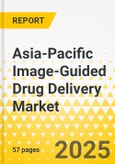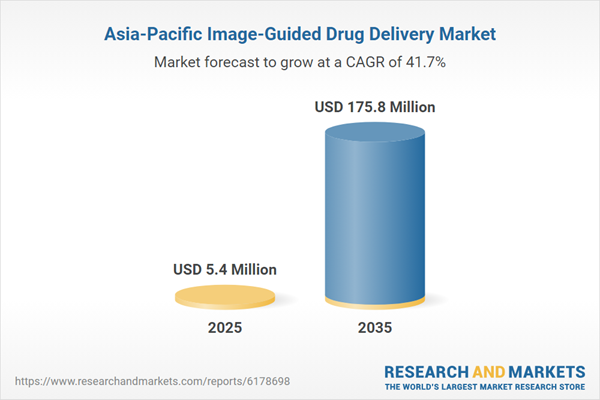This report comes with 10% free customization, enabling you to add data that meets your specific business needs.
Market Introduction
The APAC image-guided drug delivery (IGDD) market is witnessing rapid growth, driven by rising demand for precision medicine in Asia-Pacific and advancements in advanced imaging drug delivery technologies With the use of minimally invasive, precisely targeted procedures, IGDD makes it possible to administer treatments directly to disease areas, such as tumors and brain regions. This method improves treatment outcomes while lowering systemic toxicity by offering a safer and more patient-specific substitute for traditional systemic medications.Oncology, neurology, and regenerative medicine are important uses of IGDD in the APAC area; oncology dominates the market because of the rising incidence of cancer. Clinicians may now deliver chemotherapeutics, gene therapies, and cell-based treatments with greater precision and control thanks to the integration of catheters and cannulae with imaging platforms like MRI, CT, and ultrasound, which is aided by robots and AI-driven navigation.
An aging population, an increase in the prevalence of chronic illnesses, the development of new healthcare facilities, and growing knowledge of cutting-edge treatment alternatives are some of the factors driving regional growth. While emerging economies like India and Southeast Asia exhibit substantial development potential, leading nations like China, South Korea, Japan, and Australia are driving adoption.
The APAC IGDD market is expected to grow significantly in spite of obstacles including high costs, complicated regulations, and technological constraints, making image-guided drug delivery a key component of next-generation precision medicine in the area.
Market Segmentation
Segmentation 1: By Technology Type
- Drug-Delivery Systems
- Image-Guided Platforms
Segmentation 2: By Application
- Oncology
- Neurology
- Others
Segmentation 3: By End User
- Hospitals
- Pharmaceutical & Biotechnology Companies
- Contract Research Organizations (CROs)
- Research Institutes & Universities
Segmentation 4: By Region
- Asia-Pacific
- Japan
- India
- China
- Australia
- South Korea
- Rest-of-Asia-Pacific
APAC Image-Guided Drug Delivery Market Trends, Drivers and Challenges
Market Trends
- Technological Integration: Adoption of imaging modalities such as MRI, CT, PET, and ultrasound combined with advanced drug delivery systems is increasing across APAC.
- Minimally Invasive Procedures: Growing preference for less invasive techniques improves recovery times and treatment outcomes.
- AI and Robotics: Implementation of AI-guided navigation and robotic-assisted delivery systems is enhancing therapeutic accuracy and precision.
- Personalized Medicine: Rising focus on patient-specific treatments is fostering adoption of targeted drug delivery approaches.
- Digital Healthcare Expansion: Integration with telemedicine and digital health platforms supports better monitoring and control of IGDD therapies.
Market Drivers
- Rising Chronic Disease Incidence: Increased prevalence of cancer, neurological disorders, and other chronic illnesses fuels demand for targeted therapies.
- Aging Population: Growing geriatric demographics in countries like Japan, China, and South Korea drive the need for advanced drug delivery solutions.
- Healthcare Infrastructure Growth: Expansion of hospitals, specialized cancer centers, and diagnostic facilities facilitates IGDD adoption.
- Government Initiatives: Supportive policies, funding for healthcare innovation, and medical research programs accelerate market growth.
- Technological Advancements: Continuous improvements in imaging, drug delivery devices, and AI-enabled platforms enhance treatment efficacy and safety.
Market Challenges
- High Costs: Initial investment and maintenance costs of IGDD systems can be prohibitive for smaller healthcare facilities.
- Regulatory Complexity: Navigating diverse regulations across APAC countries slows market entry and adoption.
- Technical Limitations: Integration of imaging modalities with drug delivery systems can be complex, impacting precision.
- Limited Awareness: Low patient and clinician awareness in emerging markets hinders widespread adoption.
- Data Privacy & Security: Handling sensitive imaging data requires stringent compliance with data protection laws across different APAC nations.
How can this report add value to an organization?
Product/Innovation Strategy: The report offers in-depth insights into the latest technological advancements in Image-Guided Drug Delivery, enabling organizations to drive innovation and develop cutting-edge products tailored to market needs.Growth/Marketing Strategy: By providing comprehensive market analysis and identifying key growth opportunities, the report equips organizations with the knowledge to craft targeted marketing strategies and expand their market presence effectively.
Competitive Strategy: The report includes a thorough competitive landscape analysis, helping organizations understand their competitors’ strengths and weaknesses and allowing them to strategize effectively to gain a competitive edge in the market.
Regulatory and Compliance Strategy: It provides updates on evolving regulatory frameworks, approvals, and industry guidelines, ensuring organizations stay compliant and accelerate market entry for new Image-Guided Drug Delivery
Investment and Business Expansion Strategy: By analyzing market trends, funding patterns, and partnership opportunities, the report assists organizations in making informed investment decisions and identifying potential M&A opportunities for business growth.
This product will be delivered within 2 business days.
Table of Contents
Table Information
| Report Attribute | Details |
|---|---|
| No. of Pages | 57 |
| Published | October 2025 |
| Forecast Period | 2025 - 2035 |
| Estimated Market Value ( USD | $ 5.4 Million |
| Forecasted Market Value ( USD | $ 175.8 Million |
| Compound Annual Growth Rate | 41.7% |
| Regions Covered | Asia Pacific |









